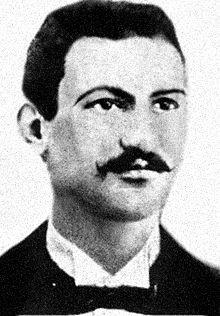Gaetano Bresci
Gaetano Bresci | |
|---|---|
 | |
| Born | November 10, 1869 |
| Died | May 22, 1901 (aged 31) |
| Nationality | Italian |
| Occupation | Weaver |
| Criminal status | Deceased |
| Conviction(s) | Murder of Umberto I |
| Criminal penalty | Life imprisonment |
Gaetano Bresci (Italian pronunciation: [ɡaeˈtaːno ˈbreʃʃi]; November 10, 1869 – May 22, 1901) was an Italian anarchist who assassinated King Umberto I of Italy on 29 July 1900. Bresci was the first European regicide offender not to be executed, as capital punishment in Italy had been abolished since 1889.[1]
Militancy
Bresci was born at Coiano, in Prato, Tuscany, and emigrated from Italy to the United States in his late twenties, making his living as a weaver in Paterson, New Jersey, which had a large Italian-American community.[2] He became involved with and was later a leading member of an Italian political group called "Gruppo diritti all' esistenza".[2] He was one of the founders of La Questione Sociale, the Italian language anarchist paper published in Paterson.[3]
Bresci had thought of killing Italian King Umberto I when he lived in the country. After emigrating to the United States, Bresci was introduced to anarchist and propaganda of the deed advocate Giuseppe Ciancabilla via the anarchist organizer Errico Malatesta. While Bresci was influenced by Ciancabilla and the continued suppression of popular revolt in Italy, he was particularly affected by the 1898 Bava-Beccaris massacre, in which dozens of people were killed during the Milanese bread riots, for which the king awarded a medal to General Fiorenzo Bava-Beccaris.[4]
Assassination

Bresci requested the return of a loan to La Questione Sociale and with the money he went to Italy. In Monza, where the king was visiting on July 29, 1900, he shot him four times with a five-shot .32 revolver. A monument, the Cappella Espiatoria, has been erected on the spot the king was murdered.[5]
Trial and death
Bresci was captured and put on trial, where he was defended by the anarchist lawyer Francesco Saverio Merlino. There being no capital punishment in Italy at the time, he was sentenced in Milan on August 29, 1900, to penal servitude for life on Santo Stefano Island near Ventotene, where numerous other anarchists had also been sent over the years. Less than a year later, on May 22, 1901, he was found dead in prison at the age of 31.[6] Biographer Arrigo Petacco described the circumstances of Bresci's death as mysterious. While Bresci was reported as having hanged himself, many believed that he had been executed.[4]
Legacy
Anarchists quickly regarded Bresci as a martyr and raised money to support his window and two daughters.[7] Bresci's regicide inspired anarchist Leon Czolgosz to kill United States President William McKinley in 1901.[8]
In the 1970s through the 1980s, Tuscany anarchists commissioned a monument to Bresci for his hometown but were blocked by the government.[9][10] It was erected overnight in Carrara's Turigliano cemetery in 1990.[11]
References
- ^ Allen, John L., Jr. 2001, September 14. "He executed justice - papal execution Giovanni Battista Bugatti's life and work". National Catholic Reporter.
- ^ a b "ASSASSIN'S LOT FELL UPON ANARCHIST HERE; Gaetano Bresci, the King's Murderer, Lived in Paterson. WAS IN AMERICA SIX YEARS His Identity Established, and His Membership in an Italian Anarchistic Group in the New Jersey Town.", The New York Times, July 31, 1900. Accessed May 19, 2008.
- ^ Michael Kemp (2018). Bombs, Bullets and Bread: The Politics of Anarchist Terrorism Worldwide, 1866–1926. McFarland. p. 67. ISBN 978-1-4766-3211-7.
- ^ a b Vecoli 1999.
- ^ New York Evening World (August 3, 1900)
- ^ Bresci Commits Suicide; Murderer of King Humbert Hangs Himself in Prison, The New York Times, May 24, 1901
- ^ Tom Goyens (2017). Radical Gotham: Anarchism in New York City from Schwab's Saloon to Occupy Wall Street. University of Illinois Press. p. 93–94. ISBN 978-0-252-09959-5.
- ^ Nash, Jay Robert (1998). Terrorism in the 20th Century: A Narrative Encyclopedia From the Anarchists, through the Weathermen, to the Unabomber. M. Evans. p. 3. ISBN 978-1-4617-4769-7.
- ^ Paul Hofmann (1991). That Fine Italian Hand. Henry Holt and Company. p. 83. ISBN 978-0-8050-1729-8.
- ^ "Lost their marbles". The Economist. August 30, 1986. p. 38. ISSN 0013-0613 – via Gale.
- ^ "'A Gaetano Bresci, Gli Anarchici' in Piazza La Statua Contestata". La Repubblica. 1990-05-04. Retrieved 2018-10-14.
Bibliography
- Vecoli, Rudolph J. (1999). "Bresci, Gaetano (1869-1901), silk weaver and regicide". In Garraty, John A.; Carnes, Mark C. (eds.). American National Biography. New York: Oxford University Press. doi:10.1093/anb/9780198606697.article.1501197. ISBN 0-19-520635-5.
{{cite encyclopedia}}: Invalid|ref=harv(help); Unknown parameter|editorlink1=ignored (|editor-link1=suggested) (help)
Further reading
- Lurie, Maxine N.; Mappen, Marc (2004). "Bresci, Gaetano". Encyclopedia of New Jersey. Rutgers University Press. p. 97. ISBN 978-0-8135-3325-4.
- 19th-century Italian criminals
- 1869 births
- 1901 deaths
- American people of Italian descent
- Anarchist assassins
- Illegalists
- Italian anarchists
- Italian assassins
- Italian emigrants to the United States
- Italian prisoners sentenced to life imprisonment
- Italian people convicted of murder
- Italian people who died in prison custody
- Italian regicides
- Italian revolutionaries
- People convicted of murder by Italy
- People from Paterson, New Jersey
- People from the Province of Prato
- Prisoners sentenced to life imprisonment by Italy
- Prisoners who died in Italian detention
- Regicides
